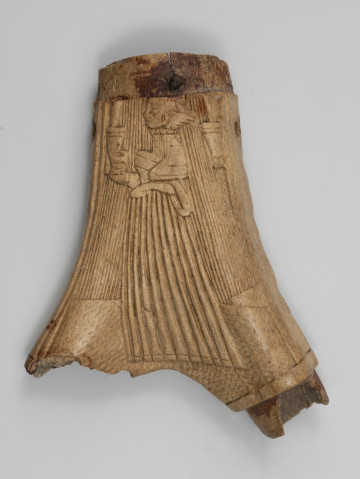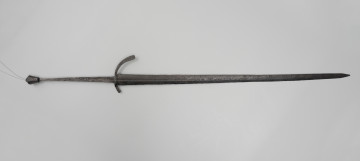
Schiavona broadsword
circa 1590 — 1610
National Museum in Szczecin
Part of the collection: Militaria
In the Middle Ages, the sword was not only an effective weapon but also held an important symbolic meaning, alluding to justice and freedom Having a sword meant you are a member of one of the privileged states - feudal or knightly. A sword was used to invest someone into the knighthood. With its shape resembling the sign of the cross, it was given to sovereigns for their merits in defending the Church, becoming an important symbol of medieval Christian culture. Blunt-edged swords were also used by executioners to dispense justice. The blades bore religious inscriptions and prayers shortened to initials, which is the case of the described double-edged sword with a one-handed grip and a discoid head. When it came to combat gear bordering the sacred and the profane, it was not insignificant who crafted the equipment, which is why many swords were marked with house marks. Typically, it was the blacksmith who prepared the blade and placed his mark on the tang; then the swordsmith followed with sanding and polishing it along with inserting his own mark or other inscriptions, as well as binding the grip. The smith left so-called thumbprints on the tang of the example from the Szczecin collection, which has a straight crossed hilt. The print was produced by means of a heated rod applied to the hilt at a 45° angle. Both sides of the fuller are engraved with inscriptions, each with four groups of initials, punctuated by the signs of a bachelor's cross inscribed in a circle. The inscriptions are completed with a Greek omega and a symbol representing a leaf with a hatched field joined by a dash with the peen, and a rosette in the form of a circle with rays ending in "pearls", interpreted as a solar sign. Justyna Bądkowska
Author / creator
Object type
single-handed sword
Technique
forging, fine detail finishing
Material
iron, tin
Origin / acquisition method
acquisition
Creation time / dating
Creation / finding place
Owner
Muzeum Narodowe w Szczecinie
Identification number
Location / status

circa 1590 — 1610
National Museum in Szczecin

1501 — 1600
National Museum in Szczecin

circa 1390 — 1450
National Museum in Szczecin
DISCOVER this TOPIC
National Museum in Szczecin
DISCOVER this PATH
Educational path